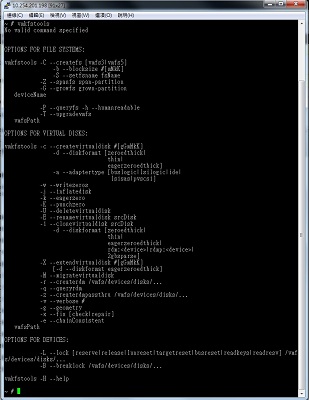
Vmkfstools Windows 10
Attention, Internet Explorer User Announcement: VMware Communities has discontinued support for Internet Explorer 7 and below. Broadcom wireless driver windows 10 macbook pro download. In order to provide the best platform for continued innovation, VMware Communities no longer supports Internet Explorer 7.
VMware Communities will not function with this version of Internet Explorer. Please consider upgrading to Internet Explorer 8, 9, or 10, or trying another browser such as Firefox, Safari, or Google Chrome. (Please remember to honor your company's IT policies before installing new software!) • • • •.

Some things should be simple, shrinking a thin provisioned virtual disk should be one of them, it’s not. This will just reduce the VMDK’s usage on the VMFS datastore NOT resize the “provisioned size” of a thin disk. To shrink a VMDK we can use an ESX command line tool “vmkfstools”, but first you have to zero out any free space on your thin provisioned disk. On Windows guests we can use the (replace the [DRIVE:] with the relevant Windows drive letter) you must use v1.6 or later!: sdelete.exe -z [DRIVE:] This will fill any unused space on the drive specified with zero-blocks. Caution: This operation will expand your thin-disk to its maximum size, ensure your datastore has the capacity to do this before you run this operation.
As of v1.6 -c and -z have changed meanings, many instructions say -c zeros free space, this is no longer the case, it zeros the space then fills with random data in accordance with DOD spec: DOD 5220.22-M, the trigger to zero space with 0x00 has changed to -z! On linux guests use: dd if=/dev/zero of=/[PATH]/zeroes bs=4096 && rm -f /[PATH]/zeroes Again, replace [PATH] with the relevant path to a location on the target storage device. Next we will shut down the guest OS and SSH into the ESX shell, once in the shell we need to navigate to the VMDK’s datastore -> directory and we’ll check the VM’s actual size: du -h [DISKNAME].vmdk Punch all zeroed blocks out of the VMDK: vmkfstools --punchzero [DISKNAME].vmdk Check the size again (will now be less): du -h [DISKNAME].vmdk Of course, replace [DISKNAME] with your VMDK’s actual name. There we have it, all that free space, now reclaimed. Why not follow for more like this! I tested the procedure on a test VM and I’m ok with this, so thank you!; on the production server, though, I’d like to verify wheter my datastore has the necessary free space in order to the expand vmdk to full size, BEFORE actually running SDELETE. Now, since I had a lot of deleted data recently (spring cleanups!) I have this numbers to work with: Provisioned Disk: 1.5 T Used Space (from Win OS): 562 Gb VMDK actual size is 1.128 Tb so if I run SDelete I’m going to need about 400 Gb free space on the datastore, right?
Nice, succinct explanation, Myles. Am I correct in assuming the following: 1.
Vmkfstools reports the same volume twice. Workaround: Reboot your Windows system. Problems using vmkfstools to create VMFS3 volume when using VML name of LUN. Vmkfstools is a vSphere CLI tool available on every ESXi host and can be used to perform various activities against the VMFS volumes and virtual disks. The idea behind the article was to provide various options available when using vmkfstools with Virtual Disks.
In VMware, the Provisioned Space represents how much space I set the size of the TP VMDK disk to be, and Used Space is how much of that VMDK is no longer considered free space by VMware? Panchatantra stories in kannada pdf stories english. After running the steps outlined in your post, the free space in the VMDK will be aligned with the actual free space in the OS?